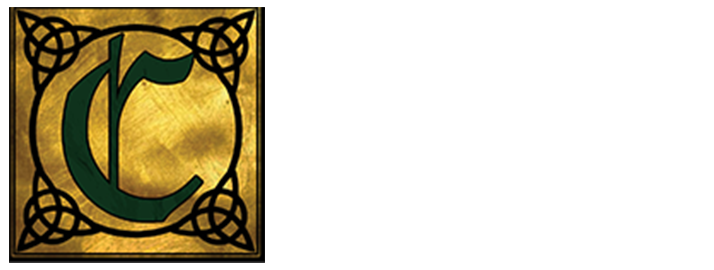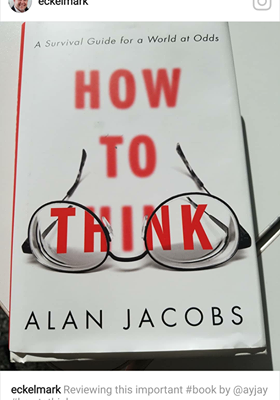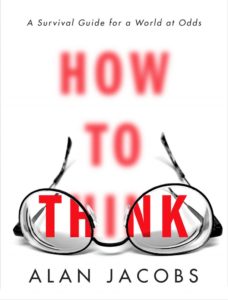Read this book!
 Research is the deliberation of the owl. Research is the spider’s methodical construction of her web. Research is the beaver building his dam, branch by branch. Research is the cat surveying her territory, still, silent, awaiting the opportunity to pounce. Masters and doctoral work demands these and other zoomorphic metaphors of care, craft, and concision in research. Yet, while processes are taught and rubrics followed in creating dissertations, what is often missing in the research process is the training of the mind or How to Think. If there were one book that every Christian educator should read in advance of and during any research, Alan Jacobs has written a small, power-packed engagement for those who care about mindset construction.
Research is the deliberation of the owl. Research is the spider’s methodical construction of her web. Research is the beaver building his dam, branch by branch. Research is the cat surveying her territory, still, silent, awaiting the opportunity to pounce. Masters and doctoral work demands these and other zoomorphic metaphors of care, craft, and concision in research. Yet, while processes are taught and rubrics followed in creating dissertations, what is often missing in the research process is the training of the mind or How to Think. If there were one book that every Christian educator should read in advance of and during any research, Alan Jacobs has written a small, power-packed engagement for those who care about mindset construction.
 Book introductions tend to be throwaway pages since writers tend to simply give an overview of their thinking. But Jacobs breaks the mold using the introduction as the precis for not only the book’s purpose but for construction of human thoughtfulness. The reader is familiarized with names which should inhabit research habits: Kahneman, Haidt, Ariely, Fried, Robinson, and Eliot. Thinking processes are also introduced: anchoring, Dunning-Kruger effect, cognitive biases, Refutation Mode, and pejorative naming (e.g., “Puritanism”). Alan Jacobs’ fine introduction for How to Think is stacked with insights, ideas, innovators, and intellectuals whose thoughts should be considered ahead of any research process. In fact, How to Think will generate so many outside connections that the reader will be spending money on many more books.
Book introductions tend to be throwaway pages since writers tend to simply give an overview of their thinking. But Jacobs breaks the mold using the introduction as the precis for not only the book’s purpose but for construction of human thoughtfulness. The reader is familiarized with names which should inhabit research habits: Kahneman, Haidt, Ariely, Fried, Robinson, and Eliot. Thinking processes are also introduced: anchoring, Dunning-Kruger effect, cognitive biases, Refutation Mode, and pejorative naming (e.g., “Puritanism”). Alan Jacobs’ fine introduction for How to Think is stacked with insights, ideas, innovators, and intellectuals whose thoughts should be considered ahead of any research process. In fact, How to Think will generate so many outside connections that the reader will be spending money on many more books.
 Jacobs first explodes the fallacy of thinking for oneself,saying simply “it’s not a good idea” in chapter one. Thinkers have problems with their own thinking because they tend to think by themselves. Researchers (1) are whole people who must consider every aspect of their person invested in the research and (2) live in relationship with otherswhether they are met face-to-face or not. Of course, the flip-side of others-centered research is “group think” well documented in chapter two. Jacobs’ watchwords concerning posture, prudence, approach, and disposition are not to dismissed. Cultural maxims such as “tolerance” are often paid lip service in research but are woefully lacking in practice throughout chapter three. Assumptions, word-choice, online speed, and true versus false prejudices are a few of the “repulsions” Jacobs’ chapter denotes.
Jacobs first explodes the fallacy of thinking for oneself,saying simply “it’s not a good idea” in chapter one. Thinkers have problems with their own thinking because they tend to think by themselves. Researchers (1) are whole people who must consider every aspect of their person invested in the research and (2) live in relationship with otherswhether they are met face-to-face or not. Of course, the flip-side of others-centered research is “group think” well documented in chapter two. Jacobs’ watchwords concerning posture, prudence, approach, and disposition are not to dismissed. Cultural maxims such as “tolerance” are often paid lip service in research but are woefully lacking in practice throughout chapter three. Assumptions, word-choice, online speed, and true versus false prejudices are a few of the “repulsions” Jacobs’ chapter denotes.
 Words are the stock-in-trade of any thinker-writer-researcher yet can create their own problems.Metaphors, dichotomizing, “terministic screens,” and “in-other-wording” are just a few of the problem areas met in chapter four. Taxonomies and categorization are a continuation of the problems found in chapter five, rightly entitled “lumping.” Open minds – a fallacy explained and taken to task in chapter six – create fanatics and echo chambers rather than competent scholars. Understanding others’ minds is the short, impactful chapter seven where the reader learns the importance of code-switching: learning another’s cultural, linguistic dialect so as to enter into cultural conversation with forbearance (1 Cor 13:7; Eph 4:2; Col 3:13). The surprise of seeing that biblical word applied to thinking humanizes other thinkers and their thinking.
Words are the stock-in-trade of any thinker-writer-researcher yet can create their own problems.Metaphors, dichotomizing, “terministic screens,” and “in-other-wording” are just a few of the problem areas met in chapter four. Taxonomies and categorization are a continuation of the problems found in chapter five, rightly entitled “lumping.” Open minds – a fallacy explained and taken to task in chapter six – create fanatics and echo chambers rather than competent scholars. Understanding others’ minds is the short, impactful chapter seven where the reader learns the importance of code-switching: learning another’s cultural, linguistic dialect so as to enter into cultural conversation with forbearance (1 Cor 13:7; Eph 4:2; Col 3:13). The surprise of seeing that biblical word applied to thinking humanizes other thinkers and their thinking.
 The power of Jacobs humanizing others is the strength of his book. He forces readers to see their reflections in the mirror. The “us versus them” mentality is too easily a substitute for thinking even in higher education. Over and over Jacobs calls attention to partisanship, polarization, and tribalism as the driving force behind unfair assessments. Applied to Christian higher education, words like “fairness” and “equity” should be readily observed; but that is not always the case. In a rush to demonstrate the wrong of another position or another approach there is a tendency to pillory the person, seeing research as adversarial if it does not fit within the scope of an accepted position or presupposition. But when we see ourselves as the corruptible persons we are, we are much more ready to identify with this centerpiece statement:
The power of Jacobs humanizing others is the strength of his book. He forces readers to see their reflections in the mirror. The “us versus them” mentality is too easily a substitute for thinking even in higher education. Over and over Jacobs calls attention to partisanship, polarization, and tribalism as the driving force behind unfair assessments. Applied to Christian higher education, words like “fairness” and “equity” should be readily observed; but that is not always the case. In a rush to demonstrate the wrong of another position or another approach there is a tendency to pillory the person, seeing research as adversarial if it does not fit within the scope of an accepted position or presupposition. But when we see ourselves as the corruptible persons we are, we are much more ready to identify with this centerpiece statement:
Over the years, I’ve had to acknowledge that some of the people whose views on education appall me are more devoted to their students than I am to mine; and that some of the people whose theological positions strike me as immensely damaging to the health of the church are nevertheless more prayerful and charitable, more Christlike, than I will ever be. . . . Being around those people forces me to confront certain truths about myself that I would rather avoid; and that alone is reason to seek every means possible to constrain the energies of animus (76-77).
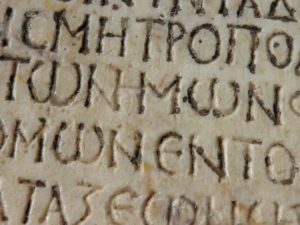 I would offer three Greek concepts as summation of Jacobs’ concern here and throughout the book. Chronos carries with it the expanse of time not only to be dutiful to the amount we spend in our studies but the time we spend with others. It is one thing to interact with words on a page, quite another to converse face-to-face. Spending time with others in pursuit of truth is the essence of incarnational education.Logos sets our sights on words, the very delivery system for which academics depend. Yet we are not always honest with our words, definitions, or interpretations of others’ words. Jacobs makes us come to grips with our sometimes lack of honesty in our reportage. Ethos suggests the disposition, mindset, or attitude with which we approach our subjects or our students. Our approach born of our internal outlook necessitates a pruning for which we are incapable of wielding the shears. We need what Jacobs calls “the thinking person’s checklist” (155-56); that which keeps us “right-minded” so we can be “fairest-minded.” The summation of How to Think in three words gives an overview of a book which should be read and reread for all who care to think or teach others the discipline.
I would offer three Greek concepts as summation of Jacobs’ concern here and throughout the book. Chronos carries with it the expanse of time not only to be dutiful to the amount we spend in our studies but the time we spend with others. It is one thing to interact with words on a page, quite another to converse face-to-face. Spending time with others in pursuit of truth is the essence of incarnational education.Logos sets our sights on words, the very delivery system for which academics depend. Yet we are not always honest with our words, definitions, or interpretations of others’ words. Jacobs makes us come to grips with our sometimes lack of honesty in our reportage. Ethos suggests the disposition, mindset, or attitude with which we approach our subjects or our students. Our approach born of our internal outlook necessitates a pruning for which we are incapable of wielding the shears. We need what Jacobs calls “the thinking person’s checklist” (155-56); that which keeps us “right-minded” so we can be “fairest-minded.” The summation of How to Think in three words gives an overview of a book which should be read and reread for all who care to think or teach others the discipline.
 Spiders, beavers, cats, and owls give animalistic characteristics to their designed work in creation. Researchers would be well served to appropriate not only their characteristics for research processes but the pace with which life is achieved. One of the key concerns in thinking is the need to slow down. In a rush to produce and publish there is a need for reflection, for what the Psalmist calls selah: to pause, consider, deliberate, ponder, and think. Thinking takes time (chronos) to correctly assemble words (logos) to create from a faithful mindset (ethos). For the Christian educator our salvific regeneration should produce a sanctified restoration of How to Think. [See bibliographic reference below.]
Spiders, beavers, cats, and owls give animalistic characteristics to their designed work in creation. Researchers would be well served to appropriate not only their characteristics for research processes but the pace with which life is achieved. One of the key concerns in thinking is the need to slow down. In a rush to produce and publish there is a need for reflection, for what the Psalmist calls selah: to pause, consider, deliberate, ponder, and think. Thinking takes time (chronos) to correctly assemble words (logos) to create from a faithful mindset (ethos). For the Christian educator our salvific regeneration should produce a sanctified restoration of How to Think. [See bibliographic reference below.]
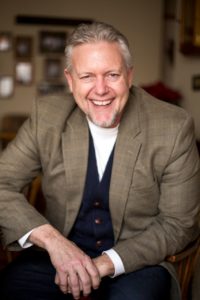 This review will appear in the Fall, 2018 issue of Christian Education Journal. Dr. Mark Eckel loves spending time with Christian young people on the college campus each week. Mark is President of The Comenius Institute (website), spends time with Christian young people in public university (1 minute video), hosts a weekly radio program with diverse groups of guests (1 minute video), interprets culture from a Christian vantage point (1 minute video), and his video teaching on Old Testament Overview, Wisdom, and Suffering is also available (video).
This review will appear in the Fall, 2018 issue of Christian Education Journal. Dr. Mark Eckel loves spending time with Christian young people on the college campus each week. Mark is President of The Comenius Institute (website), spends time with Christian young people in public university (1 minute video), hosts a weekly radio program with diverse groups of guests (1 minute video), interprets culture from a Christian vantage point (1 minute video), and his video teaching on Old Testament Overview, Wisdom, and Suffering is also available (video).
Picture credit: snappygoat.com
How to Think: A Survival Guide for a World at Odds. By Alan Jacobs. New York, NY: Currency. 2017. 157 pp. $23.00. hardcover. Reviewed by Dr. Mark Eckel, Capital Seminary and Graduate School, Lancaster, PA. [Word Count: 1078]
